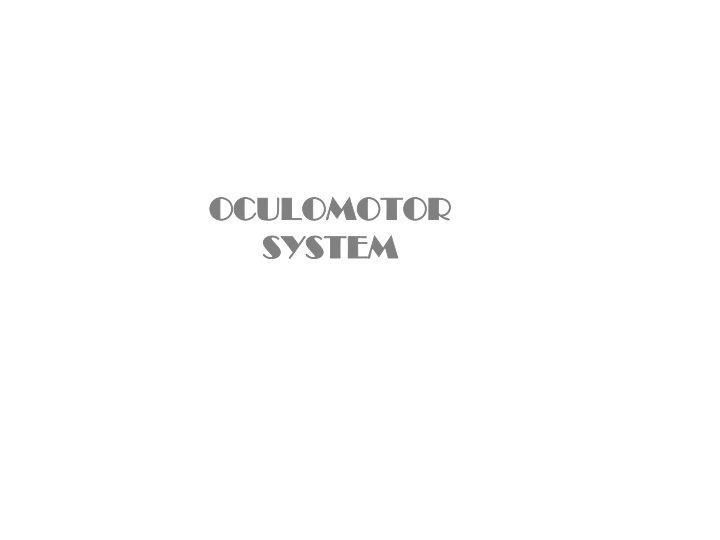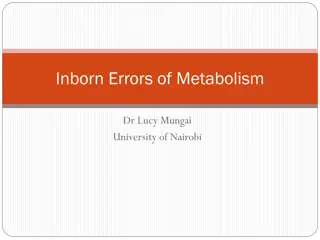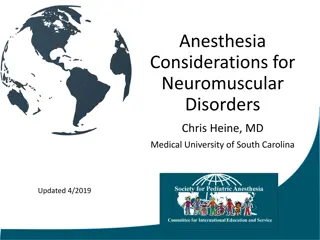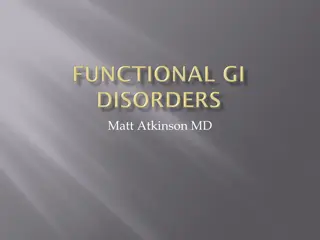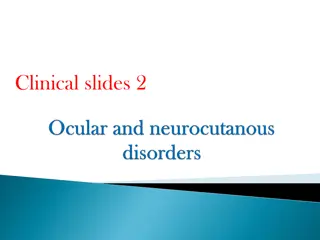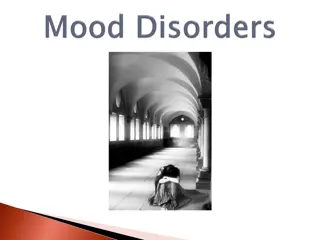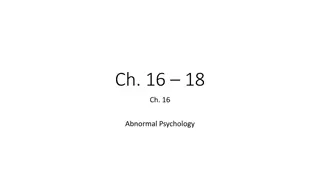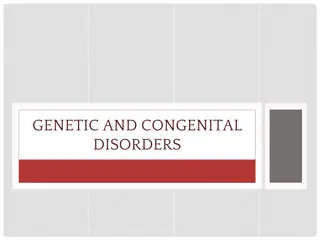Oculomotor System Disorders Overview
Oculomotor system disorders encompass a range of conditions affecting the intricate network involving the oculomotor nerve and associated structures. From nuclear IIIrd nerve palsies to fascicular syndromes and uncal herniation syndrome, various pathologies can disrupt eye movement control and pupillary responses. Understanding the subnuclear arrangements, specific prerequisites for diagnosis, and cardinal signs like pupil involvement are crucial in assessing and managing these complex disorders.
Download Presentation

Please find below an Image/Link to download the presentation.
The content on the website is provided AS IS for your information and personal use only. It may not be sold, licensed, or shared on other websites without obtaining consent from the author.If you encounter any issues during the download, it is possible that the publisher has removed the file from their server.
You are allowed to download the files provided on this website for personal or commercial use, subject to the condition that they are used lawfully. All files are the property of their respective owners.
The content on the website is provided AS IS for your information and personal use only. It may not be sold, licensed, or shared on other websites without obtaining consent from the author.
E N D
Presentation Transcript
OCULOMOTOR OCULOMOTOR SYSTEM SYSTEM
1storder neuron retina to pretectal nucleus nasal fibres contralateral pretectal nucleus temporal fibres ipsilateral pretectal nucleus 2ndorder neuron connects each pretectal nucleus to both edinger westphal nuclei,therefore unilateral light stimulus bilateral symmetrical pupillary constriction damaged by syphilis light near dissociation 3rdorder neuron E.W. nucleus to ciliary ganglion Aneurysm 3rdnerve palsy + pupil involvement In orbit parasympathetic fibres inferior division of 3rd nerve via nerve to I.O. ciliary ganglion 4thorder neuron leaves ciliary ganglion , passes with short ciliary nerves- innervate the sphincter pupillae
7 types of 3rdcn palsies 1. nuclear IIIrd nerve palsies 2. fascicular syndromes of the IIIrd nerve 3. uncal herneation syndrome of IIIrd nerve 4. posterior communicating artery aneurysm 5. cavernous sinus syndrome of IIIrd nerve 6. orbital syndrome of the IIIrd nerve 7. pupil-sparing, isolated IIIrd nerve palsies
1) nuclear IIIrd nerve palsies - very rare specific prerequisites for diagnosis based on IIIrd n. subnuclear arrangements ORIGIN:3rdnerve complex in periaqueductal gray matter just anterior to the aqueduct of sylvius at level of superior colliculus The MLF abuts the the nucleus laterally and ventrally LATERAL SUBNUCLEUS-ipsilateral IO+IR+MR(inferior division) MEDIAL SUBNUCLEUS-contralateral SR(major clue in identifying nuclear palsy) CENTRAL CAUDAL SUBNUCLEUS-b/l LPS EW SUBNUCLEUS-parasympathetic innervation b/l superior division
2) fascicular syndromes of the IIIrd nerve - IIIrd nerve + superior cerebellar peduncle = Nothnagel s syndrome - IIIrd nerve + red nucleus = Benedikt s syndrome - IIIrd nerve + cerebral peduncle = Weber s syndrome - IIIrd nerve + superior cerebellar peduncle + red nucleus = Claude s syndrome
3) uncal herneation syndrome of IIIrd nerve - IIIrd passes along free edge of tentorium cerebelli - with expanding supratentorial mass lesions, the uncal portion of the undersurface of the temporal lobe may compress the IIIrd nerve Pupil is usually involved early and predominantly- HUTCHINSON PUPIL Generally ipsilateral 3rd cn palsy but sometimes contralateral(false localizing) A false localizing hemiparesis is much more common than a false localising 3 rd cn palsy
5) cavernous sinus syndrome of IIIrd nerve - involvement of III +/- IV +/- VI nerves +/- oculosympathetics - may give rise to primary misdirection syndromes of the IIIrd nerve Aberrant Regeneration of the IIIrd Nerve = misdirection syndrome = acquired oculomotor synkinesis Bielschowsky s Hard-Wiring theory: - after a IIIrd palsy, anomalous branching develops during regeneration so that structures originally supplied are anomalously re-innervated on the basis of miswiring = secondary misdirection syndromes primary misdirection syndromes = where no previous IIIrd nerve palsy was present eyelid-gaze dyskinesis pseudo grafes sign-upper lid may retract on down gaze due to IR fibres aberrantly innervating LPS pupil-gaze dyskinesis pseudo argyll robertson pupil pupillary light reaction is poor but constriction occurs on ocular adduction with early convergence or horizontal gaze
4) posterior communicating artery aneurysm-most common cause of painful, non-traumatic, IIIrd nerve palsy 3rd cn passes between posterior cerebral artery and superior cerebellar artery parallel to posterior communicating artery PUPIL RULE-complete isolated 3rd cn palsy with pupil sparing is never due to aneurysm
6) orbital syndrome of the IIIrd nerve - at orbital apex, IIIrd nerve splits into superior division (levator + SR muscle) and the inferior division (MR, IR, IO & parasympathetics) - divisional IIIrd nerve palsies arise which are of localizing value to this locale Pseudodivisional palsy-incomplete lesions involving fascicles in midbrain
7) pupil-sparing, isolated IIIrd nerve palsies - small caliber, poorly myelinated parasympathetic fibers tend to locate to the superonasal portion of the peripheral IIIrd nerve - 80% of diabetic IIIrd nerve palsies are pupil sparing - 95% of compressive IIIrd nerve palsies have pupil involvement Microvascular palsies are sudden onset painful,usually pupillary sparing,begin to resolve by about 2 months and donot result in aberrant regeneration Pupillomotor fibres pass superficially in superomedian part of nerve supplied by pial blood vessels while main trunk of 3rd nerve is supplied by vasa nervosum Therefore aneurysm presses on pial vessels externally total 3rd nerve palsy including pupils Microangiopathy affects vasa nervosa- produces pupil sparing 3rd nerve palsy
very short fascicular course so fascicular syndromes are rare - IVth nerve usually affected at point of decussation [ = anterior medullary velum] or along subarachnoid course clinically: - a IVth nerve palsy is the most common, isolated oculomotor nerve palsy seen - in almost all of the neurological literature, a VIth nerve palsy is always quoted as #1 - the major problem in diagnosis is in only 30% of recent onset IVth n. palsies is the diplopia maximal down-and-in where it customarily assessed - vertical diplopia after closed head trauma is a IVth n. palsy until proven otherwise
FASCICULUS Passes through red nucleus and then through medial aspect of cerebral peduncle Lesion of the fasciculus leads to: BENEDIKT S SYNDROME damage to dorsal part of fasciculus as it passes through red nucleus leads to ipsilateral 3rd nerve palsy , contralateral ataxia ,flapping tremors. WEBERS SYNDROME- damage to the ventral part of fasciculus as it passes through cerebral peduncle leads to ipsilateral 3rd nerve palsy, contralateral hemiplegia.
